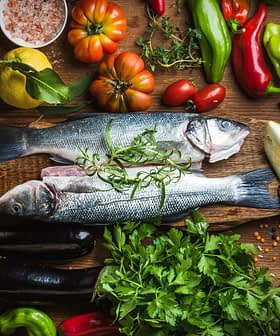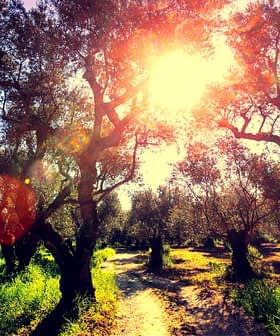Teaching America’s Bravest Med-Style Survival
A Harvard professor urges firefighters in America to turn to a Mediterranean style of eating to avoid on-duty heart attacks.
Stefanos Kales of Harvard University is working to improve the health of firefighters by encouraging them to follow a Mediterranean diet, rich in olive oil and other healthy staples. Kales’ ongoing project in Indianapolis aims to educate firefighters on the benefits of the Mediterranean diet, with hopes of improving their physical condition and eating preferences.
Stressful working conditions, high adrenaline, and risk. These are some common characteristics of the everyday day life of firefighters when on duty, but it turns out that flames and fumes are not their biggest problem.
The chances for firefighters to undergo a heart attack increase ten-fold to one-hundred-fold when in the field than when in the station.
In America, it has been found that cardiovascular disease is the leading cause of on-duty deaths of firefighters, and no strategies to encourage healthy eating are established. Stefanos Kales, a professor of medicine at Harvard Medical School, wants to pave a safer path for firefighters by changing their food culture to adapt to the dietary principles of countries bordering the Mediterranean sea with olive oil in the vanguard.
“Some firefighters and their families already used olive oil, many did not,” Kales told Olive Oil Times. “They really appreciate the olive oil, however, other items such as Greek olives were not big hits. This appears to be a matter of what people are used to eating or not and willing to try,” he explained.
Kales descends from a Greek family which moved to the United States about 100 years ago.
“In Greece, the consumption of olive oil per person is double than in Italy or Spain,” he said. “We literally bathe our food in olive oil. We also have strained yogurt and table olives which, if prepared in the traditional way, are a superfood.”
He unremittingly follows the Mediterranean diet and acknowledges that his grandmother was the most influential person in shaping his everyday menu.
“She was not educated, but she had common sense and had mastered the art of traditional cooking,” he said. “My parents were lured by the nutritional trend of the time which treated good and bad fats the same and promoted dietary products, while my grandmother insisted on using olive oil, collecting wild vegetables, and using them to make pies for us.”
As a senior in college back in 1992, Kales was assigned the task to medically attend to a hazmat team, which consisted of specially trained firefighters to deal with hazardous chemical materials.
He soon realized that the team members were not suited for their job — not because they were not properly trained — but because of their eating habits; many were obese and their lab examination results were not looking good.
“One of them weighed almost 200 kilos (441 Lbs.), another had extremely high triglycerides. We had to do something,” Kales recalled.
“I totally respect the firefighters as professionals. However, about 35 to 40 percent of firefighters do not exercise or do any sport, and half of the volunteers were overweight,” he said. “The chances for firefighters to undergo a heart attack increase ten-fold to one-hundred-fold when in the field than when in the station.”

Stefanos Kales
Kales has been working with firefighters for 25 years now, along with his other research interests and teaching at the university. He came up with a pioneering approach to help Indianapolis firefighters perform better in the field and withstand the on-duty perils.
The firefighters taking part in the program were separated into two groups: one group received eating recommendations based on the Mediterranean diet, while the others kept eating habits unchanged. Then, the groups will switch roles and dietary routine.
“In 2015 we received a state fund of $1.5 million and we initiated a program with the firefighters of Indianapolis,” he said of his venture. “About 350 firefighters enrolled and remain in the Indianapolis study. One half of these were first introduced to our program’s educational materials and website a year ago. They also received some samples of free extra virgin olive oil and other Mediterranean food staples at several points during the year.”
The project is no walk in the park for Kales and his team. “With 44 fire stations distributed throughout the city of Indianapolis, it is challenging to provide face-to-face education and interaction. Thus, we have relied on a participant website that provides information, recipes, videos, etc.,” he said.
“When in the intervention, the firefighters also get coupons monthly for healthy foods at a major supermarket chain. The other group of firefighters went one year without any changes and they are now entering the intervention phase. The feedback we are getting is they are anxious to try it out. Time will tell how well it goes.”
The project is still ongoing and it is scheduled to last for two years. “We are now entering month 13 of 24 months. We need to await the full data collection and analyses to see how effective we were in getting people to use olive oil and use more olive oil if they were already consumers,” Kales explained. At the end of the project, the collected data will be analyzed to indicate differences between the two groups of firefighters in terms of eating preferences and physical condition.
According to the scientific report of the Dietary Guidelines Advisory Committee of 2015, the Mediterranean diet is accepted and recommended as a healthy eating pattern for Americans. The work of Kales and his team is one of the few that examine effective applications of the diet in real-world settings and, apart from helping the firefighters, it will provide the basis for interventions in other professional groups like the military and law enforcement employees.









